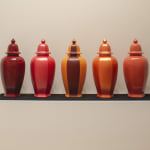



Allan McCollum United States, b. 1944
19 10/16 x 8 4/16 x 8 4/16 in
each : 50 x 21 x 21 cm
Further images
Perfect Vehicles (five vessels) displayed in the exhibition 1986 is a succession of 5 vessels from his Perfect Vehicles series in a warm colour gradient from orange to dark red. McCollum’s series Perfect Vessels consists of a number of containers made of enamelled hydrocal reminiscent of Chinese ginger jars cast, a traditional vessel that has been extensively copied and reproduced for centuries. Each sculpture is thickly painted in a different hue of commercially available paint and has no opening, utterly eliminating the typical use—value that one might expect of a vase. He installed them in groups ranging from five to fifty. Not only do they refer to Chinese culture, but they could also be understood as cremation urns, addressing death. Jars and vases are cross-culturally symbolic as collectibles and through highlighting this everyday object, McCollum primarily refers to the custom of saving and collecting objects in today’s society. He emphasises how every day practical objects can transform over time into something of superior value.
The American artist Allan McCollum, born in Los Angeles, California in 1944, moved to New York in 1975 where he currently lives and works. He creates sculptures exploring the correlation between the individuality of an object as well as its derivation from mass production, reflecting on today’s society. Inspired by the Fluxus movement and artworks by conceptual artists, such as Sol LeWitt and Daniel Buren, Allan McCollum introduced an artistic process of studio manufacture of sculptural objects made in unlimited editions. He is creating a seemingly infinite number of objects, indiscernible from one another, displayed on walls or laid out on tables. Using the multiple as a point of departure, McCollum questions the impact of the infinite multiple on the viewer. McCollum’s repetition is also in a way inquiring what defines an art object, commenting on the journey of an object from object to icon to symbol. He collaborated several times with other artist of his generation, including Laurie Simmons, Andrea Fraser. McCollum has had over 100 solo exhibitions in Europe and in the United States. His work was shown in major institutions including Van Abbemuseum, Eindhoven, Netherlands (1989); Artists Space, New York (1979–80); Denver Art Museum (1990); Musée d'art moderne de Lille Métropole, Portikus, Frankfurt (1988); Villeneuve d'Ascq, France (1998); and Musée d'art moderne et contemporain, Geneva (2006) as well as at the Venice Biennale in 1988 and at the Sao Paolo Biennial in 2008. Today, the artist’s works are part of important museum collections around the world such as the Art Institute of Chicago, the National Gallery of Art in Washington, D.C., the Fotomuseum Winterthur in Switzerland, and The Museum of Modern Art in New York.
Provenance
Cash/Newhouse GalleryMrs Lilly (Lily) Friedman
326 Gallery, NY



